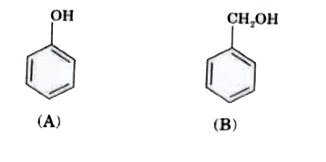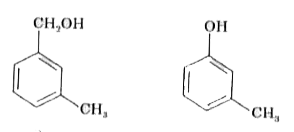What are phenols? How do they differ structurally from aromatic alcohols?
Step-by-Step Text Solution:
1. Definition of Phenols:
- Phenols are organic compounds characterized by the presence of a hydroxyl group (-OH) attached directly to an aromatic hydrocarbon ring. The simplest example of a phenol is phenol itself (C6H5OH), where the -OH group is attached to a benzene ring.
2. Structure of Phenols:
- In phenols, the carbon atom to which the hydroxyl group is attached is part of the aromatic system. This carbon is typically sp² hybridized, meaning it is involved in a planar structure with a bond angle of approximately 120 degrees.
3. Definition of Aromatic Alcohols:
- Aromatic alcohols, on the other hand, are compounds where the hydroxyl group is attached to a carbon atom that is not part of the aromatic ring itself. Instead, the -OH group is connected to an aliphatic carbon that is adjacent to the aromatic ring.
4. Structure of Aromatic Alcohols:
- In aromatic alcohols, the carbon atom bearing the hydroxyl group is typically sp³ hybridized. This means that the carbon atom is tetrahedral in shape with bond angles of about 109.5 degrees.
5. Key Differences:
- The primary structural difference between phenols and aromatic alcohols lies in the attachment of the hydroxyl group:
- In phenols, the -OH group is directly attached to an sp² hybridized carbon in the aromatic ring.
- In aromatic alcohols, the -OH group is attached to an sp³ hybridized carbon that is adjacent to the aromatic ring.
6. Conclusion:
- Both phenols and aromatic alcohols contain the hydroxyl functional group and are considered aromatic compounds. However, their structural differences in the attachment of the -OH group lead to different chemical properties and reactivities.
---
- Phenols are organic compounds characterized by the presence of a hydroxyl group (-OH) attached directly to an aromatic hydrocarbon ring. The simplest example of a phenol is phenol itself (C6H5OH), where the -OH group is attached to a benzene ring.
- In phenols, the carbon atom to which the hydroxyl group is attached is part of the aromatic system. This carbon is typically sp² hybridized, meaning it is involved in a planar structure with a bond angle of approximately 120 degrees.
- Aromatic alcohols, on the other hand, are compounds where the hydroxyl group is attached to a carbon atom that is not part of the aromatic ring itself. Instead, the -OH group is connected to an aliphatic carbon that is adjacent to the aromatic ring.
- In aromatic alcohols, the carbon atom bearing the hydroxyl group is typically sp³ hybridized. This means that the carbon atom is tetrahedral in shape with bond angles of about 109.5 degrees.
- The primary structural difference between phenols and aromatic alcohols lies in the attachment of the hydroxyl group:
- In phenols, the -OH group is directly attached to an sp² hybridized carbon in the aromatic ring.
- In aromatic alcohols, the -OH group is attached to an sp³ hybridized carbon that is adjacent to the aromatic ring.
- Both phenols and aromatic alcohols contain the hydroxyl functional group and are considered aromatic compounds. However, their structural differences in the attachment of the -OH group lead to different chemical properties and reactivities.
Topper's Solved these Questions
- ALCOHOLS, PHENOLS AND ETHERSBOOK - PRADEEPCHAPTER - ALCOHOLS, PHENOLS AND ETHERSEXERCISE - ADDITIONAL QUESTIONS (LONG ANSWER QUESTIONS)
6 Videos
- ALCOHOLS, PHENOLS AND ETHERSBOOK - PRADEEPCHAPTER - ALCOHOLS, PHENOLS AND ETHERSEXERCISE - HIGHER ORDER THINKING SKILLS (QUESTIONS AND PROBLEMS WITH ANSWERS/SOLUTION)
5 Videos
- ALCOHOLS, PHENOLS AND ETHERSBOOK - PRADEEPCHAPTER - ALCOHOLS, PHENOLS AND ETHERSEXERCISE - ADDITIONAL QUESTIONS (VERY SHORT ANSWER QUESTIONS)
58 Videos
- ALDEHYDES, KETONES AND CARBOXYLIC ACIDS BOOK - PRADEEPCHAPTER - ALDEHYDES, KETONES AND CARBOXYLIC ACIDS EXERCISE - IMPORTANT QUESTIONS FOR BOARD EXAMINATION
29 Videos
Similar Questions
Knowledge Check
Which of the following compounds is aromatic alcohol?

 AA,B,C,DBA,DCB,CDA
AA,B,C,DBA,DCB,CDA
What are the two types of mRNAs ? How do they differ ?
View SolutionWhat are plant growth hormones ? How do they differ from growth regulators ?
View SolutionWhich of the following compunds is aromatic alcohol?

View SolutionWhat are metallic interstitial hydrides? How do they differ from molecular hydrides?
View SolutionHow do fungi differ from algae ?
View SolutionFungi differ from algae in being
View SolutionHow do algae differ from fungi?
View Solution
